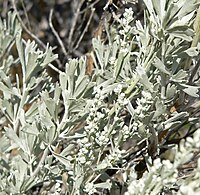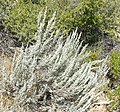Artemisia tridentata
| Artemisia tridentata subsp. var. | Sagebrush | |||||||||||||||||||||||||||||||||||||||||||||||||||||||
|---|---|---|---|---|---|---|---|---|---|---|---|---|---|---|---|---|---|---|---|---|---|---|---|---|---|---|---|---|---|---|---|---|---|---|---|---|---|---|---|---|---|---|---|---|---|---|---|---|---|---|---|---|---|---|---|---|

|
|
| ||||||||||||||||||||||||||||||||||||||||||||||||||||||
| ||||||||||||||||||||||||||||||||||||||||||||||||||||||||
Artemisia tridentata (also called sagebrush/common sagebrush, big sagebrush, blue/black sagebrush or mountain sagebrush) is a shrub or small tree from the family Asteraceae. Some botanists treat it in the segregate genus Seriphidium, as S. tridentatum (Nutt.) W. A. Weber, but this is not widely followed. The vernacular name "sagebrush" is also used for several related members of the genus Artemisia, such as California Sagebrush (Artemisia californica).
It is a coarse, hardy silvery-grey bush with yellow flowers and grows in arid sections of the western United States and Western Canada. It is the primary vegetation across vast areas of the Great Basin desert. Along rivers or in other relatively wet areas, sagebrush can grow as tall as 3 m (10 feet), but is more typically 1-2 m tall.
Sagebrush has a strong pungent fragrance, especially when wet, which is not unlike common sage. It is, however, unrelated to common sage and has a bitter taste. It is thought that this odor serves to discourage browsing.
Sagebrush leaves are wedge-shaped 1-4 cm long and 0.3-1 cm broad, and are attached to the branch by the narrow end. The outer and wider end is generally divided into three lobes (although leaves with two or four lobes are not uncommon), hence the scientific name tridentata. The leaves are covered with fine silvery hairs, which are thought to keep the leaf cool and minimize water loss. Most of the leaves are carried year-round, as sagebrush tends to grow in areas where winter precipitation is greater than summer precipitation.
Sagebrush flowers in the late summer or early fall. The flowers are yellow and are carried in long, slender clusters.
Sagebrush is not fire-tolerant and relies on wind-blown seeds from outside the burned area for re-establishment.
| Standard Cyclopedia of Horticulture |
|---|
|
Artemisia tridentata, Nutt. Sage Brush. Shrubby, reaching height of 12 ft. although often only a foot high, branchy, canescent: Lvs. wedge-shaped, 3-7-toothed or lobed, truncate at the summit, the uppermost ones narrower: heads 5-8-fld. Plains, W. Intro. 1881.
|
Cultivation
Propagation
Pests and diseases
Varieties
There are five subspecies:
- Artemisia tridentata subsp. parishii (A. Gray) H. M. Hall & Clem. (Syn. A. parishii A. Gray, A. tridentata var. parishii (A. Gray) Jeps.)
- Artemisia tridentata subsp. tridentata
- Artemisia tridentata subsp. vaseyana (Rydb.) Beetle (Syn. A. tridentata var. vaseyana (Rydb.) B. Boivin, A. vaseyana Rydb.)
- Artemisia tridentata subsp. wyomingensis Beetle & A. L. Young (Syn. A. tridentata var. wyomingensis (Beetle & A. L. Young) S. L. Welsh)
- Artemisia tridentata subsp. xericensis Winward ex Rosentreter & R. G. Kelsey
Gallery
References
- Standard Cyclopedia of Horticulture, by L. H. Bailey, MacMillan Co., 1963
External links
- w:Artemisia tridentata. Some of the material on this page may be from Wikipedia, under the Creative Commons license.
- Artemisia tridentata QR Code (Size 50, 100, 200, 500)



